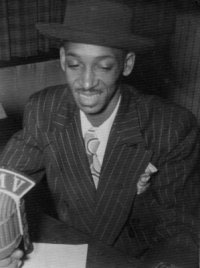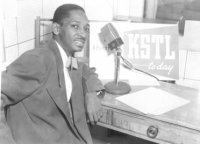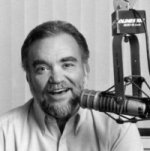Radio Articles
Price Was St. Louis’ First Black Disc Jockey
Sometimes it’s hard to imagine life in the “old” days, especially when those who have firsthand knowledge are no longer around. Such is the case when it comes to remembering St. Louis’ first black disc jockey.

Wiley Price, Jr. got his first radio job in 1944 at WTMV, then a local powerhouse station with studios in the Broadview Hotel in East St. Louis. He was 31 years old. The country was at war and Negroes were considered 2nd class citizens. What would possess a radio station to hire one and put him on the air into a high-profile job?
Even though WTMV was only operating with a 250 watt output at 1490 Kc., the station had an excellent reputation for news, sports and entertainment in the region. It once boasted in a promotional article that 35 of its people had graduated to “big time” radio within a five year period.
In the 1940s and ‘50s, a person could carve out a radio career by being a savvy self-promoter. Station owners were always interested if money could be made, so many announcers would buy their own time in hour-long blocks and then sell ads on their programs. Wiley Price III says, “My father could talk his way into anything.” But talk wasn’t always enough. According to radio veteran and historian Bernie Hayes, a Negro announcer would “have to convince management that he was articulate and that he could pay for the time.”
Once Price had made his case to WTMV management, he was given a late night air slot. To his listeners, he became known as “Mrs. Price’s Boy Wiley.” His radio shows were a mixture of gospel and rhythm & blues music, with gospel artists often performing live in the studio. His on-air approach was smooth and intelligent, according to the late deejay Roscoe McCrary, who would have his own program on WTMV in 1951. It was said Wiley was a “class act” on the local airwaves.
The rhythm & blues music of those days was called “race music,” according to Bernie Hayes. It was actually a mix of r&b and jazz, featuring artists like the Ink Spots, the Five Blind Boys, Ethel Waters, Andy Kirk’s Band, Cab Calloway, and many others from the Chitlin’ Circuit who emulated the sounds of the white musicians. Wiley Price’s son, Wiley III, says his dad was personally acquainted with the great jazz artists like Duke Ellington and Count Basie, and he grew up in North St. Louis with Clark Terry.
Wiley Price, Jr. was a St. Louis native, raised on Aldine on the north side, a graduate of Sumner High School with additional schooling in accountancy, and a military veteran. Hayes says of Price’s place in radio history, “He was something to be idolized by the Black community. On the air he was laid back, very sincere. Everybody liked him.”

Price moved on to work as a deejay on KXLW and KSTL, playing the same mix of music he’d become accustomed to on WTMV. He left the business when station owners insisted he start playing a new form of music that was being called “rock ‘n’ roll.” His son says Wiley Price, Jr. called it “the ignorant man’s music” and said it would never last.
The first Negro to have his own radio show in St. Louis suffered a stroke in 1961 and died at the age of 56 in 1969. The death of the market’s first Negro disc jockey did not even merit a story in either of the city’s major newspapers.
(Reprinted with permission of the St. Louis Journalism Review. Originally published 12/02)
